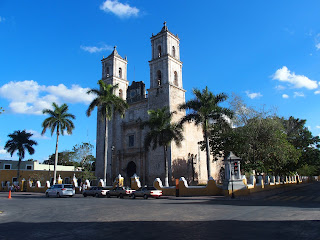Tulum
Tulum
is most famous for being the only ancient Mayan site on the edge of the
Caribbean Sea. Tulum sits on a small cliff, with access to the beach
below. Named Tulu’um by the Maya, translated to the ‘Walled City’, you can
easily see the wall built around this ceremonial city, an architectural
addition found in few Mayan sites.
Archaeologists
refer to the Tulum Ruins as Zama, the original Mayan name which means ‘The City
of Dawn’ due to its positioning towards the morning sunrise.
Tulum
was a productive port for the Maya, built and occupied during 1200 A.D. to mid
1500 A.D. The site was abandoned in the late 1500s with documentation showing
that residents were hit by disease, spread by Spanish conquerors.
Following the morning visit to Tulum we went snorkelling and swam with turtles. We had to wear buoyancy jackets and so could not dive down amongst the rays.
Coba
Another Cenote. This one underground, deep and cool and with clear water. That's me in the middle.
In the colonial town of Vallodolid
Archaeologists learned about Coba in the 1800s but dense jungle
and lack of funds made the area hard to penetrate. It is still largely
unexcavated. 120 steps lead up to the top of the Nohoch Mul pyramid, which is
137 feet tall. This is the tallest temple pyramid on the Yucatan Peninsula. The
entire site spreads over more than 30 square miles. At about 900 or 1000 AD,
Coba began a lengthy power struggle with Chichén Itzá, with the latter winning
and becoming the power of the Yucatan. It is believed that the Coba settlement
was finally abandoned when the Spanish conquered the Peninsula around 1550.
Getting to the top is straightforward but you have to be very
careful coming down. I imagine that in the not too distant future the Mexican
authorities will stop people climbing on the pyramid, as they have done at Chichén
Itzá.
The Yucatan peninsula is almost completely covered in jungle and about 2 million Mayans live there. Many speak only their particular Mayan language and live off the land. The Mexican government does much to support the lives of the Mayan people and to ensure that Mayan traditions and Mayan culture thrive. The hammock is nylon but still carefully made by hand.
The Mayans 'invented' chewing gum. As well as chewing the stuff, the ancient Mayans mixed it with other materials to bind their building blocks together. We had a mouthful of the gum - not particularly tasty because it is sugar free. The Mayan gum industry was ruined when some American chap called Wrigley saw what the Mayans were producing and went home to set up his own chewing gum company.
Cenote - a sinkhole
Cenote Cristalino is a natural sinkhole in limestone with clear, cool, fresh water. It is full of and surrounded by vegetation. A great place to swim amongst a few small fish.
Chichén Itzá
The city of Chichén
Itzá was begun around 600 A.D.
Mayan priests studied mathematics and the sun, moon, and stars. They had a very
precise calendar and were skilled builders. Carvings of gods, rulers, animals,
and battle scenes decorate the building fronts at Chichén
Itzá. All the buildings were carefully aligned to the positions of the
sun, moon, and stars.
Chichén
Itzá is about four square miles in size. The Kulkulkan Pyramid is one
of its most famous structures. It is a four-sided pyramid with a flat top. Each
side has 91 steps. With the step on the top platform, the total is 365. That is
the number of days in the solar calendar.
Pokapok court:
One of
the ways that the Mayan peoples competed against each other was by playing Pokapok.
They used a rubber ball, about 20 inches
in diameter, to play the Game, which was played on a stone court whose
measurements varied. Hanging high
on the walls were stone rings. The aim of the game
was to pass the ball around, without having it touch your hands, and then get
the ball to pass through one of the rings. Since the rings were so high and
players were not allowed to use their hands, it was extremely difficult to get
the ball through a ring. In fact, when a player did manage to get a ball
through a ring that usually ended the game.
The winners of the
game were treated as heroes and given a great feast. The penalty for losing a
game was sometimes unusually harsh: death. The leader of the team who lost the
game was sometimes killed. This fit in with the Mayan belief that human
sacrifice was necessary for the continued success of the peoples' agriculture,
trade, and overall health.
The observatory where the Mayan scientists and mathematicians would study the heavens.
The temple of the rain god Chac and part of the market place
The Kulkulkan PyramidAnother Cenote. This one underground, deep and cool and with clear water. That's me in the middle.
In the colonial town of Vallodolid
Our hotel - pretty good. Sun, sea and sand and great food.






























